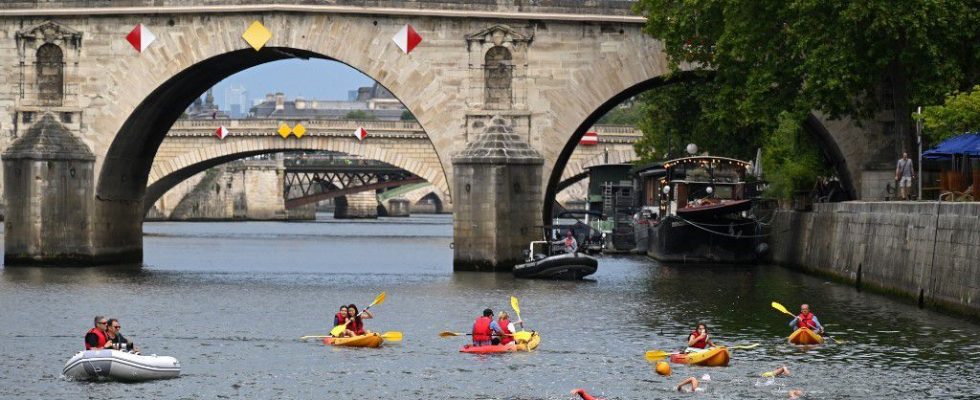With the rain which continues to fall on the capital this Friday, uncertainty still hovers over the open water swimming worlds, which are to be held on Saturday August 5 and Sunday August 6 in Paris between the Pont Alexandre III and the Pont de l’ Alma. Precipitation could spoil the quality of the water in the Seine, while the Paris City Hall wants to make this event a dress rehearsal before the 2024 Olympic Games and their swimming events in the Parisian river. On the program for these world championships: 10 kilometres, in several 1.6 km loops, between the two famous bridges. “We are monitoring the results day by day, for the moment it seems to be off to a bad start”, warned the National Swimming Federation on Thursday evening, before announcing the cancellation of this Friday morning’s training session due to a quality water below acceptable standards. However, the weekend competitions remain planned pending further testing.
Since 1990, and the promise made by Jacques Chirac to make the Seine swimmable, Paris’ candidacy for the 2024 Olympic Games has offered a unique opportunity to launch the titanic project of cleaning up the river. With 1.4 billion euros invested, work carried out throughout Ile-de-France since 2016, and multi-faceted plans such as the reconstruction of wastewater networks, disinfection in wastewater treatment plants or soil dewatering projects, the program is coming to an end. “The Seine is more and more ‘clean’, the works are on time and we will be there for the Games”, assures Pierre Rabadan, the former rugby player now deputy mayor of Paris in in charge of sport, the Olympic and Paralympic Games, and the Seine.
Giant collectors under construction
For swimmers to compete under the bridges of Paris, water analyzes must meet the standards required by the International Federation. The latter notably measure the presence of E. coli bacteria and enterococci, two bacteria of faecal origin present in wastewater. Analyzes are made every day on the course of the competition, and make it possible to classify the quality of the water according to three levels, from “insufficient” to “excellent”. “Overall, over the summer period, the quality of the water in the Seine was excellent. Until the last few days, the sanitary quality threshold required to allow swimming had been reached”, underlines Pierre Rabadan. Before the rain comes to spoil the party, the bad weather causing the overflow of the sewers, and their contaminated wastewater, into the river.
To combat this phenomenon, major work has been undertaken since 2016, in three departments: Paris, Val-de-Marne and Seine-Saint-Denis. They consist of constructing collectors to collect the excess water that has fallen during major storms, in order to prevent the rains from saturating the sewerage network. Four new works will thus be created. The most emblematic is the Austerlitz reservoir. Currently under construction, it should come into operation in 2024. This vast underground basin will be able to hold up to 50,000 m3 of rainwater, the equivalent of twenty Olympic swimming pools. “In the summer of 2024, 75% of the work planned in the water quality plan for the Seine and the Marne will have been completed, the work is progressing well and the last site delivered for the Games will be that of the Austerlitz basin” , guarantees Pierre Rabadan. Other infrastructures to discharge these storm overflows are also on the program. Like the colossal construction site of the “VL8”, a pipeline 9 kilometers long and 3 meters in diameter, which should make it possible to return the water from the collector of Athis-Mons, in the south of the capital, towards the factory of Valenton wastewater treatment.
The plan also includes soil dewatering solutions to promote rainwater infiltration. This is the case of the ParisPluie plan, adopted in 2018 and which should eventually make it possible to no longer systematically discharge this water into the sewers. Depending on the areas in Paris, the city will be able to infiltrate and reuse the rain between 4 and 16 millimeters, specifies the plan document. “The sanitation networks being less stressed, the frequency of spills in the Seine will be limited to exceptional events and its quality will be improved”, it is specified there.
Bathing in Paris as a “legacy”
Beyond the competitions this weekend, and the Olympic events, the Paris City Hall wishes to leave a swimmable Seine “as a legacy” to the inhabitants of the capital. While it has been forbidden to take a dip in the river since 1923, Anne Hidalgo unveiled three bathing sites in early July which will open in the summer of 2025. Located near the Town Hall in the center, in the district of Grenelle in the 15th arrondissement, and opposite the National Library of France, on the Bercy side, in the 12th arrondissement, they could become essential in a city increasingly confronted with heat peaks. Several other bathing sites will also open within Greater Paris in the Seine and in the Marne.
If the works are so important, it is because this objective is difficult to achieve. “It’s one thing to organize events for Olympic athletes, but it’s quite another thing to open swimming sites to the general public for several months throughout the summer period”, recalled Gabrielle Bouleaupolitical science researcher at Inrae and co-author ofa report comparing bathing site projects in Paris and Berlin. Because in the event of occasional swimming, as for a sports competition, the green light is given by the prefect of the department, after the opinion of the Regional Health Agency in particular, but if the swimming is permanent, then the quality of the water is considered within the meaning of the European directive. The various works carried out should thus make it possible to achieve these objectives. And even if, despite the measures under construction, the heavy rains could force the authorities to suspend swimming in places for one or two days, this already represents a big step towards fathoms in the shade of Haussmann buildings.
